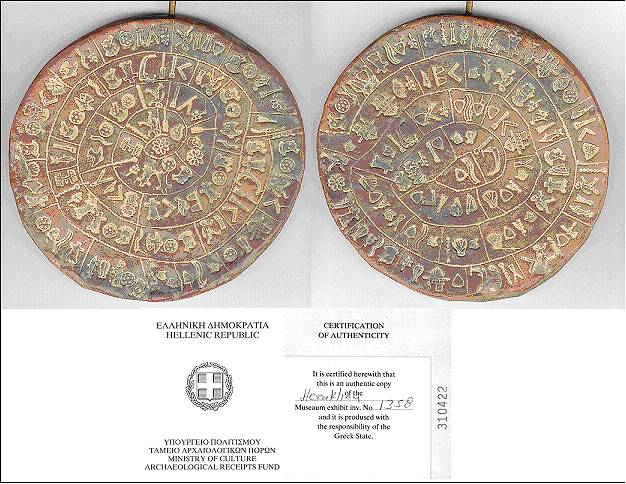
1 Introduction
The initial incentive for the present paper was the question, why not more examples of clay-imprints in Diskos-writing were found (as e.g. in comparison to Linear A and B tablets or cuneiform remains in Mesopotamia). If indeed the Diskos was unique, was it worthwhile to produce the intricate set of required punches just for this instance?
By an earlier paper in Anistoriton (Rumpel 2003) *1 the author was able to experimentally demonstrate that - given the dies – the mechanical and ceramic manufacture of the Phaistos Disk could have been rather straightforward. Also for the dies, or punches, reasonable production methods could experimentally be established. In these activities the author's opinion increased, that the punches primarily were wrought for printing on a flat surface in the way of our modern rubber-stamps or of Chinese name-stamps.
A flat surface of a less durable substrate that did not make it over the times under Cretan climatic conditions? Which substrate? Parchment? Historically too early for its application *2. Leather? Possible, as the red Indians did it. Papyrus? Recently, papyrus is growing in Ethiopia, in Egypt, in the upper Jordan valley and in Sicily, the latitudes of the latter two occurrences being comparable to that of Crete. Papyrus is represented on Minoan vases several times (cf. Marinatos/Hirmer, 1986) *3, also Diskos- character No.37 is, among others, interpreted as papyrus-flower. Further the Heraklion Museum successfully grows Papyrus on a test-ground. So papyrus is a good candidate (Warren, 1976) *4. Perhaps one should look for its pollen in Minoan-time deposits.
The present paper tries to provide further evidence for this flat-printing hypothesis by analysing the application in clay. For that aim, an Authentic Replica of the Phaistos Disk could be exploited.
Further, the spatial distribution of the character-imprints in the spirals is analysed and compared to the distribution of overprints and corrections.
2 Analysis of the Die-Impressions
Recently, the Heraklion Museum published an Authentic Replica of the Phaistos Disk (see Fig.1). Comparisons with good Diskos-pictures in Marinatos/Hirmer (1986) and Godart (1995) *5 show, that the copy is essentially faithful in two, and trustworthy also in three dimensions. Thus, the replica gives an opportunity for three-dimensional studies, which up to now could only be done on the original. This feature is exploited in the present chapter for measurement and analysis of the imprints.

2.1 Plasticine-casts of the Diskos-imprints
As a way of reconstructing the Diskos-dies, casts can be got from the character-imprints of the replica by inserting hand-warm plasticine. When cooled and carefully pressed against an inkpad, these regained top dies then can be used as punches for printing in their turn. Fig. 2 collects the results achieved in that way. This experiment shows how the dies used in the fabrication of the Diskos would have worked when printing on a flat surface. The prints are relatively clear and complete, which proves that the embossed lines forming the figures lie in one plane, which is usually not achieved by intaglio-technique nor at an intaglio-cast.
Below the characters in Fig.2, Evans' (1921) *6 numeration is given. The second number is a measurement of the character-area. This measurement was gained using a computer-printout of Fig.2 on graph paper and counting the mm-squares below the characters. As the printout was not calibrated to the actual size of the diskos characters, these measurements have only relative value. They are applied in the following study.
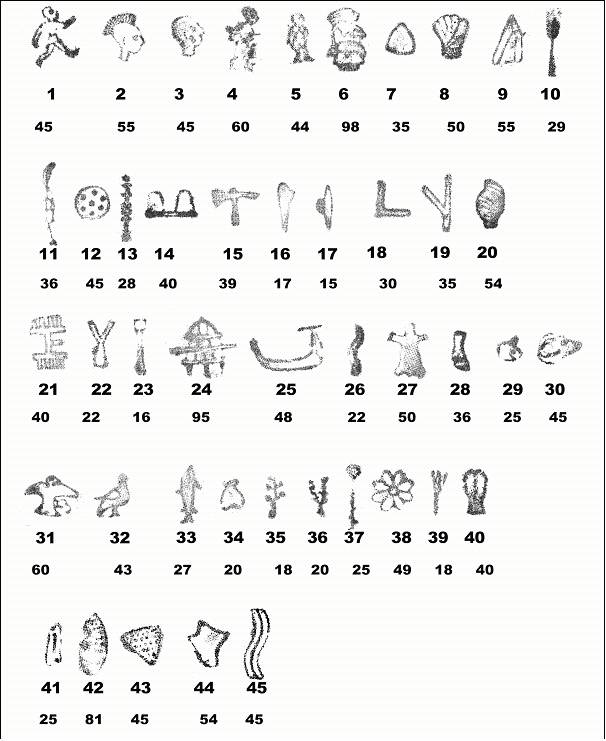
2.2 Depth of Character-Impressions
Using a calliper-rule, the depth of all character-impressions (tokens) against their surrounding was measured. This depth refers to the “body”, not to the deeper impressed outlines, of the punches. At tilted impressions, the average between two extreme measurements was taken. The results, together with the areas of the characters (types) from Fig. 2, were collected in an EXCEL-table.
Fig. 3 shows the result of the impression measurements, displayed in two colours separately for the two faces, over the character areas as gained in 2.1. The idea is that the impression-depth at equal force and time of impression should be inversely related to the area of the character. The points were averaged using the EXCEL logarithmic trend-line.

Conspicuous in Fig.3 is the considerable scatter in impression-depth from zero to 1.6 mm. As the trend-lines show, the expected effect of the character area on the impression depth is present, but it is very minute and – compared to the size of the scatter – uncharacteristic.
Also the systematic difference of the impression depth between the two faces, which was emphasized by Godard (1995), is present (see the two trend-lines). But, it is very small compared to the scatter and so does not lend itself to stronger argumentation.
2.3 Tilted character imprints
Most of the imprints were wrought well rectangular to the surface of the disk, but 43 of the 241 impressions (about 20%) are measurably tilted, maximally to 5 or 6 degrees. This is especially conspicuous with the frequent characters No.1 and No.2, where about 50% (16 of 30 cases) of their impressions are tilted. This tilt is consistently towards the side of the character with the smaller or slenderer area; at the “Runner” (1) towards his legs, at the “Featherhead” (2) towards the neck.
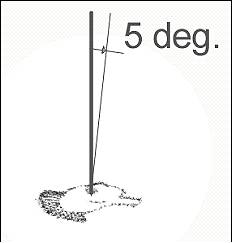
Physically, when impressing a punch into not too soft clay, the asymmetry of the character translates into a torque. The torque in its turn exerts a tilting force on the handle of the die. This force is inversely proportional to the length of the handle and will become unfelt, if the handle-length is about 10 cm or more.
Thus, if we take this more or less systematic tilt of the two characters as an indication, it seems that the clay operated on by the Diskos printer showed a remarkable backpressure and that the punch-handles were relatively short - say 2 or 3 cm - and rectangular to the faces of the punch, in order to efficiently convey the force. Both features, of course, do not comply to the ideas of Bradshaw (1976) *7 on this matter, who assumed long-handled punches with "an angle between handle and cutting-face".
2.4 Form and production of the Diskos-dies
If the conjecture is valid that the handle was rather short, then, of course, the material of the dies could also have formed the handles in a continuous way.
The fabrication of the die itself would start by grinding an even platform for the later printing-face; then forming - rectangular to this platform - the outer borders of the character by lateral abrasion of the die’s material. If – as proposed in the first paper – steatite is used as matrix, a firing process would be inserted as to harden the matrix. Then the platform would be excavated leaving the embossed lines for brim and internal details.
At character-casts showing a continuous body (e.g. No. 6, 27 and 44) the interior is shown to be excavated to a depth of about 0,2-0,3 mm, leaving a brim of the same height all around. In the same way, at characters with articulated bodies, brims are left remaining between the different body-parts or for marking e.g. eyes or ears. Character No.2 (Featherhead) shows a further modification, as the interstices between the “hairs” or “feathers” are engraved to a depth, which is about 0,1mm higher than the body. Only at 3 slender characters (No. 13, 35 and 36) no clear outline-brim can be distinguished.
2.5 Air bubbles
A certain drawback of the Diskos dies, when used for clay impression, is that their body-parts - chambered by brims - confine air. This captured air, when compressed towards the wet clay intruding the chambers, forms bubbles that deteriorate the body-surface. Fig.5 shows this effect as it is copied by a plasticine-cast of the very sensitive character No.24. Unfortunately, it cannot be decided, whether these “bubbles” were already present on the Diskos original, or were produced when forming the replica (where the same effect might have prevailed a second time). Comparisons with Godard (1995) seem to prove that at least some of the “bubbles” are original.

2.6 Conclusion
The studies above show that the dies applied in printing the Phaistos-Disk can effectively be used for printing on a flat surface. Their application in clay has even definite drawbacks against dies styled for efficient clay impression, which could have been produced with much less effort. Thus, if we assume that the Minoans were reasonable technicians, we are led to the conclusion that the Diskos-dies were originally manufactured for printing on a flat surface.
3 Analysis of the Sequential Distribution of the Characters in the Spirals
If we assume that the Diskos contains a complete context, then the main problem of the Printer was to fill this text nicely and evenly into the space provided by the spirals. If we further assume that the Printer, reasonably enough, had prepared a layout (Duhoux, 1977), then the text was completely available to him in parallel. Given these premises, the printing direction was surely a minor problem to him. Therefore, in this paragraph we shall study how accurately the printer of the Diskos solved his main problem.
3.1 Measurement of distances
The measurements given in the following are taken from Rumpel (1994) *8. They refer to a photographic reproduction of the Diskos with a diameter of 11.4 to 12 cm. If compared to the original's 15.8 to 16.5 cm diameter, the values have to be multiplied by a factor of 1.38.

Due to the stamping-process, the positions of the characters are subject to minor variations and even rotations. This makes a consistent distance measurement difficult. In order to overcome this complication, the following procedure was adopted:
Each individual character on the Diskos was marked at its "centre". The centre is defined as the point where the median lines of the horizontal and the vertical extension of the character cross (see Fig.6). Distances between characters were measured between their centre-points.
These distance measurements were sequentially listed into a PC and provided with two markers: "from character type – to character type" and "within – between 'words' "; then processed in the following way:
- For face A, it has to be remembered that one split-off sign and one later amendment have obviously changed the initial symbol-distribution in two places of the outermost winding considerably. As there is no clear information, on which to base a reconstruction of the primary printing, the distances resulting from these amended text segments were simply omitted from the following evaluation, resulting in a small reduction of the Face A-text. For Face B, no changes obviously biasing the symbol density are present
- To compensate for the different size of character types, their lateral width was evaluated and - using the markers in the sequential distance file - subtracted by halves from the distance preceding and from the distance following a character, in order to obtain a consistent measure for the clearance between characters.
- A separate average was computed for the clearances within “words”, and for the clearances between “words”. These averages were subtracted from the clearances marked accordingly.
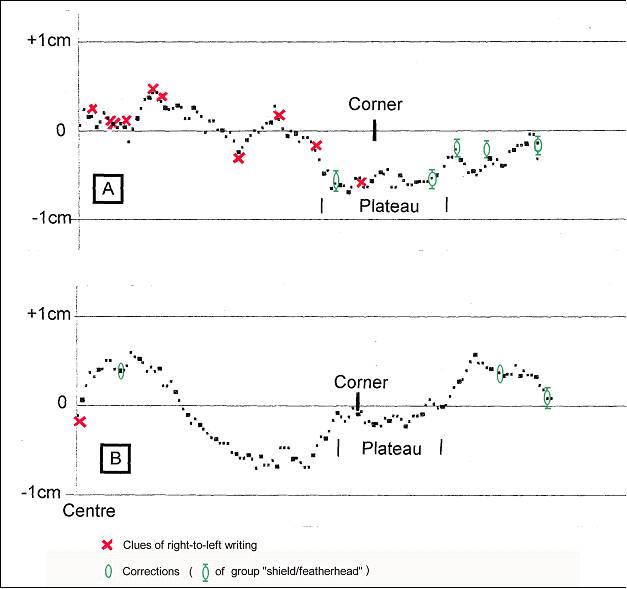
If the Diskos Printer had achieved an absolutely uniform distribution, then the final values in all places of the list should have been zero. Uniformity in this case can be compared to the movement of a clock. If a clock moves fast by only a small amount, it will run farther and farther ahead of the correct time, and vice versa. If the Diskos Printer puts one character beside the other, he also has the chance of running out of space or of finishing too early. How did he manage?
We can answer this question by "integrating", i.e. by adding-up the values gained after the above procedure (here done from the centre outward) and recording the sum obtained after each addition. If the Printer of the Diskos had done his job well, then we would expect the integral curve to always move close to the zero-line. Especially, if the deviations were only due to inaccuracies of the measurements or accidental rotations of the characters, a random-walk of the points around zero would be expected. Otherwise, by printing too dense or with too much space for a while, the Printer would lose or gain against the average and move away from the zero line.
Fig. 7 shows the result: According to the chosen direction of integration, a positive deviation means that the characters are placed too far from the centre of the Diskos, whereas a negative value means that they are too near by this amount. Fact is that the printer of the Diskos did an excellent job, because the shift is nowhere larger than about one average character width, but the visible swings are nonetheless untypical for a random walk and show series of characters placed too far from one another (curve ascending to the right), being compensated by series of characters placed too narrow (curve descending to the right).
3.2 Further relations
An interesting feature is that both curves show a plateau, where the curve is not moving upward or downward for a while, meaning that the characters are correctly spaced from one another; i.e. that the Printer gave special care at this place. The plateaus are in the same text position on both faces and coincide with the position of the "corner" in the spiral at the transition of the outermost winding to the first inner one. This corner is roughly at half of the text-length.
Interesting relations appear if we correlate the positions of further features - i.e. over-printings etc., indicative of a right to left writing direction, as well as corrections (Duhoux, 1977) *9 - of the Diskos text to the character distance distribution, as were entered in Fig.7.
It is striking, that in both Faces all indications of right-to-left writing are placed to the left of the corner, whereas all corrections except one are placed to the right of the corner, i.e. they are in the outermost winding. This funny distribution demonstrates that the corners regions indeed played a major role in the preparation of the text. The leftward writing-(printing!-) direction (which is usually taken as defining also a leftward reading direction) is only proven for the text-parts left of the corners of the two faces.
It is further seen that, of the eight corrections, six involve the same character-group "Shield-Featherhead” (Grumach, 1992) *10. It should be noted that on Face A six additional specimens of the same character-group which, as Rumpel (1990) *11 showed, could be a grammatical particle, are present to the left of the corner. These groups, for some reason, were obviously written correctly in the first instance and did not require correction.
It is no unreasonable assumption, that the Diskos-Printer, in his plight to achieve an even distribution of the characters, split the two Face-texts at half their length (i.e. about the corners) and from there stamped inward right-to-left to the centre, and in the outermost winding stamped left-to-right until he met the corner again *12. This hypothesis would also allow us to derive ad hoc a reason for the peculiar distribution of the "Shield-Featherhead"-corrections and non-corrections as follows: When printing the outer winding in the reading direction, the Printer understood the text and involuntarily provided the words with a non high-language grammatical suffix, which required later correction. Printing the inner windings, he operated against the reading direction and did not read the text as such. He formally copied - character by character - the layout and, thus, was not induced to deviate.
Such a hypothesis would be challenged by a finding of Godard (1995), who states for segment ( his No.) A VIII (in the outermost winding): "Aus der Tatsache, dass eben dieses Zeichen 6 nicht von der Tilgung betroffen ist, k?nnen wir mit absoluter Sicherheit schlie?en, dass der Verfasser des Diskos den Text gel?scht hatte, bevor er das Zeichen 6 setzte. Das hei?t, er schrieb von rechts nach links." In short: Character 6 ("Female") was not impaired by the erasure (under character 12 „Shield“), therefore it was printed later than the erasure; therefore the printing definitely went right to left.
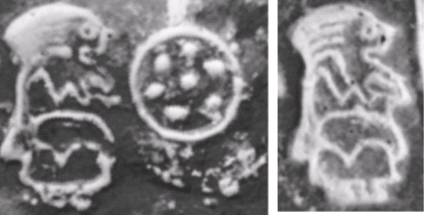
Fig.8 , at left, shows the questionable character 6 ("Female" at left, the erasure is to the right of the Female) in comparison with the same type-imprint at another text-position. It is visible, that the questionable imprint is indeed impaired by the said amendment at the frock and the elbow. As seen in the replica, the impairment consists of a compression of the clay, exerted from the erasure or correction towards the left and closing, in parts, the groove defining the outer form of the “Female”. The relief of these parts is slightly better conserved; thus, oblique illumination shows a bit more (faint) detail (see Olivier 1975)13. This factual impairment does not prove an inversion of the presumed printing-direction, because probably all corrections were achieved after the first text version was completely printed, but the above statement cannot be maintained.
In one case, on the outermost winding of Face A, the group "Shield-Featherhead" was just omitted in the first instance and had to be added later, requiring a big erasure and cramming of characters. In the right-to-left writing hypothesis, this happened at the start of a “word”. Is it a reasonable assumption that you write down a word and forget to write its beginning (even if it were a particle) ?
In any case, the question of the reading-direction should not be considered as finally answered.
4 Conclusion
The paper tries to add to the interpretation of the Phaistos Disk some more physical information, which might be useful in further work on the object.
It is demonstrated that the dies applied in printing the Phaistos-Disk can effectively be used for printing on a flat surface, whereas their application in clay has definite drawbacks. Vice versa, dies for efficient clay impression could have been produced with much less effort. Thus, if we assume that the Minoans were reasonable technicians, we are led to the conclusion that the Diskos-dies were manufactured for printing on a flat surface. Their application in clay then apparently was just casual (but fortunate for us).
In a preceding paper it was experimentally demonstrated, that – given the dies - the mechanical and ceramic manufacture of the Diskos could have been rather straightforward, if clay of a not too soft consistency was applied.
On the other hand, the present investigation of the character-imprint density and its spatial relations to the corrections and over-printings in the text makes plausible that the printing proceedings itself were much less straightforward. The right-to-left printing direction is only proven for the inner windings. Our findings leave sufficient room for alternative printing stratagems as well as for doubts on the presumed equation writing = reading direction.
REFERENCES